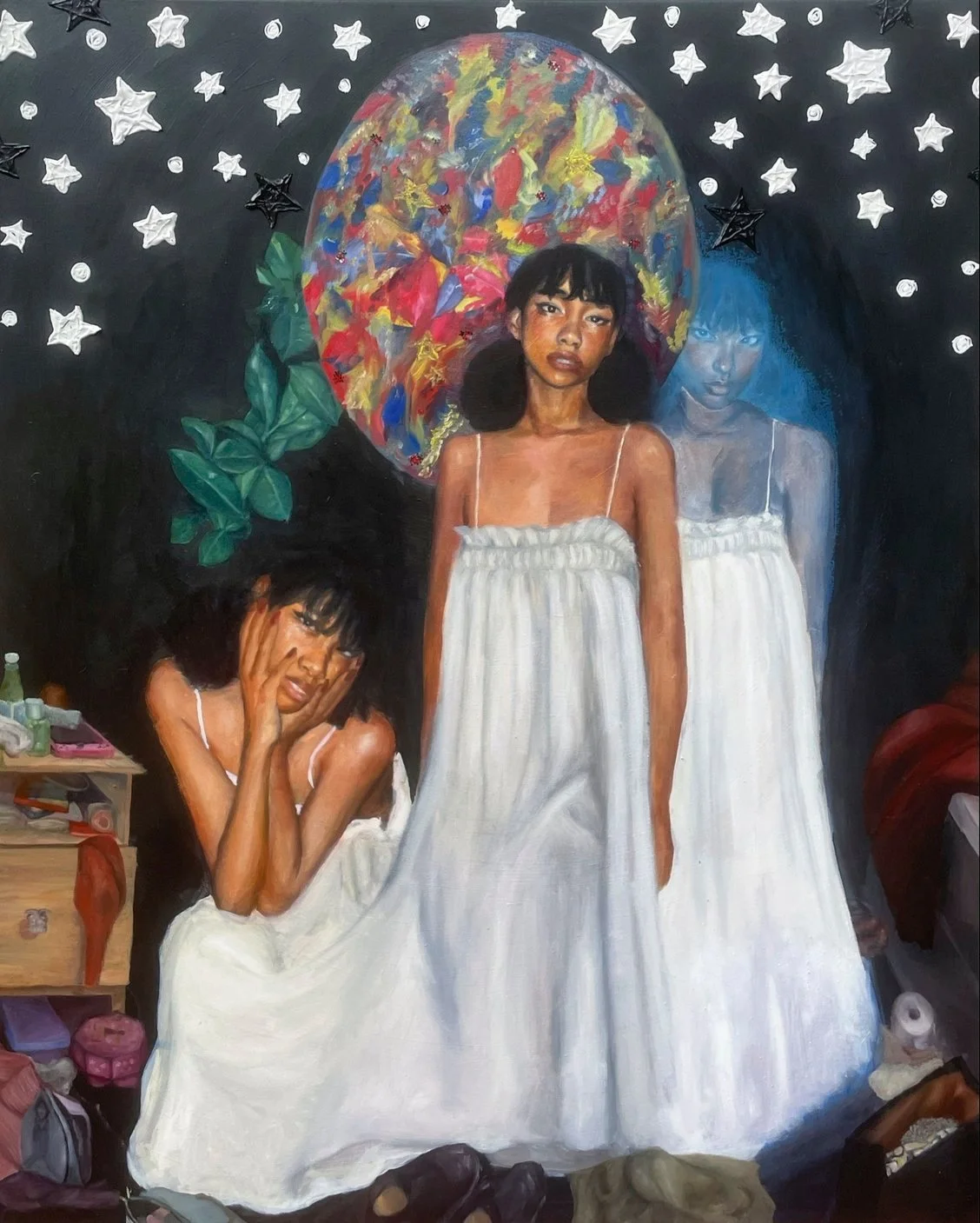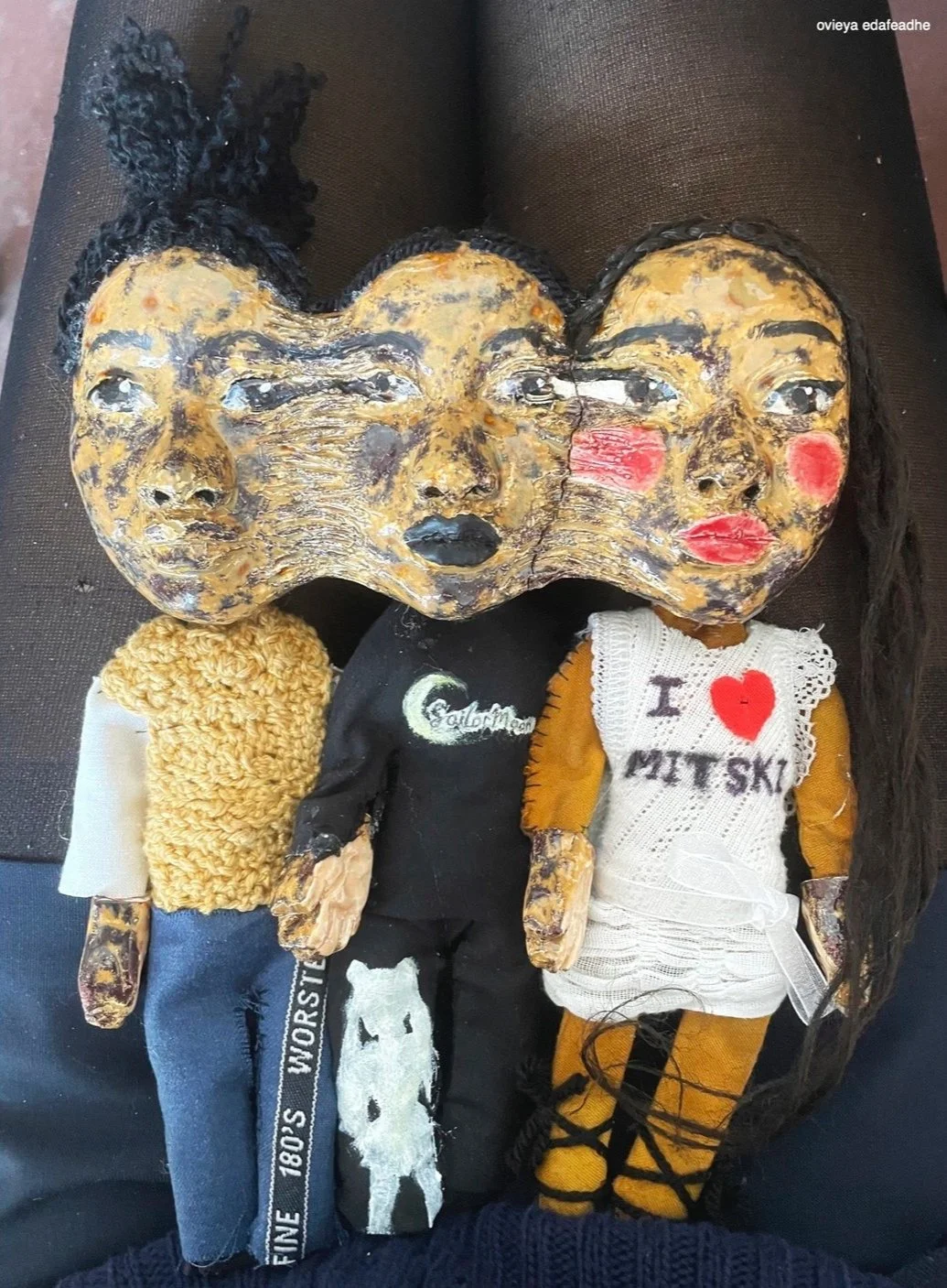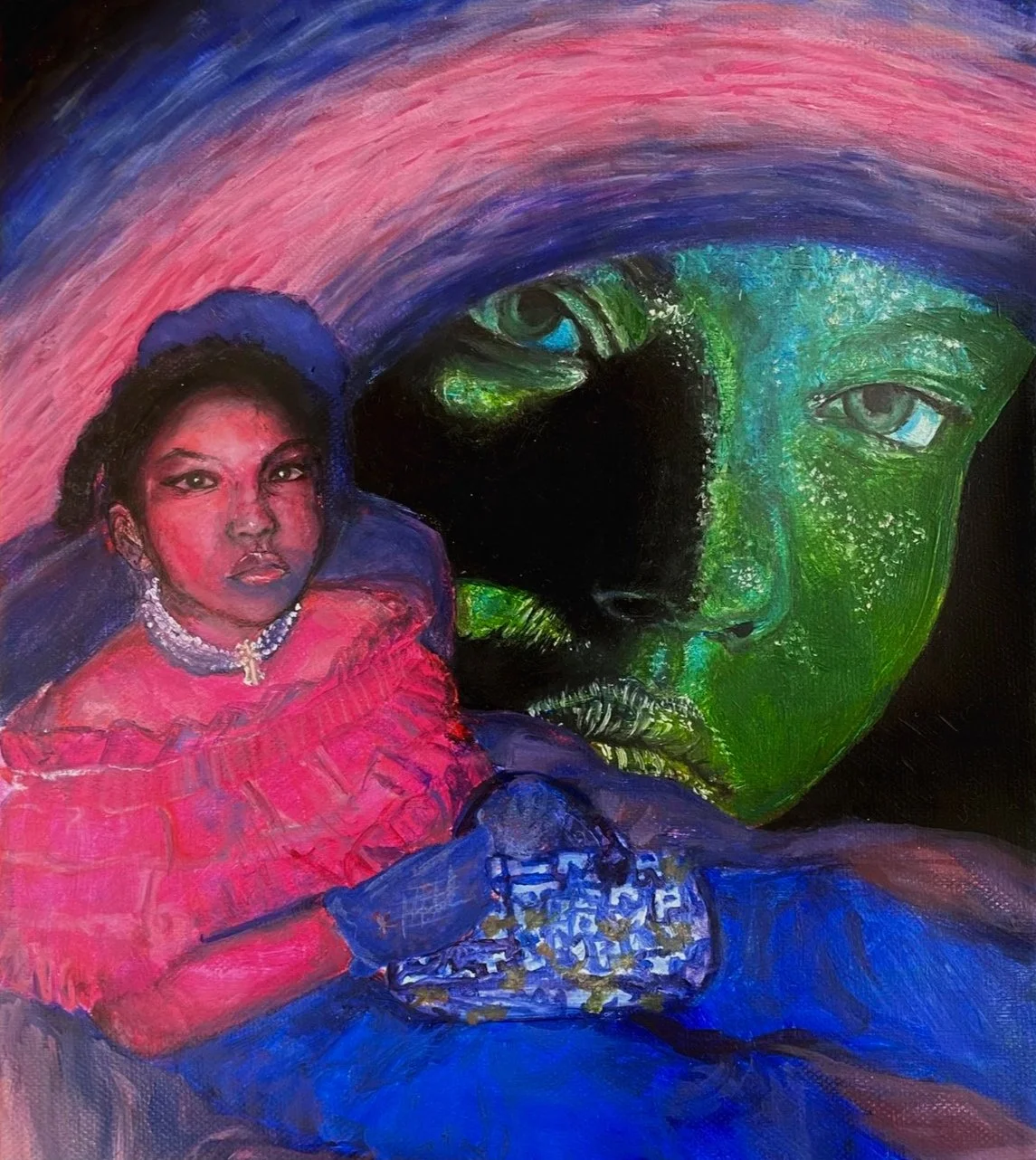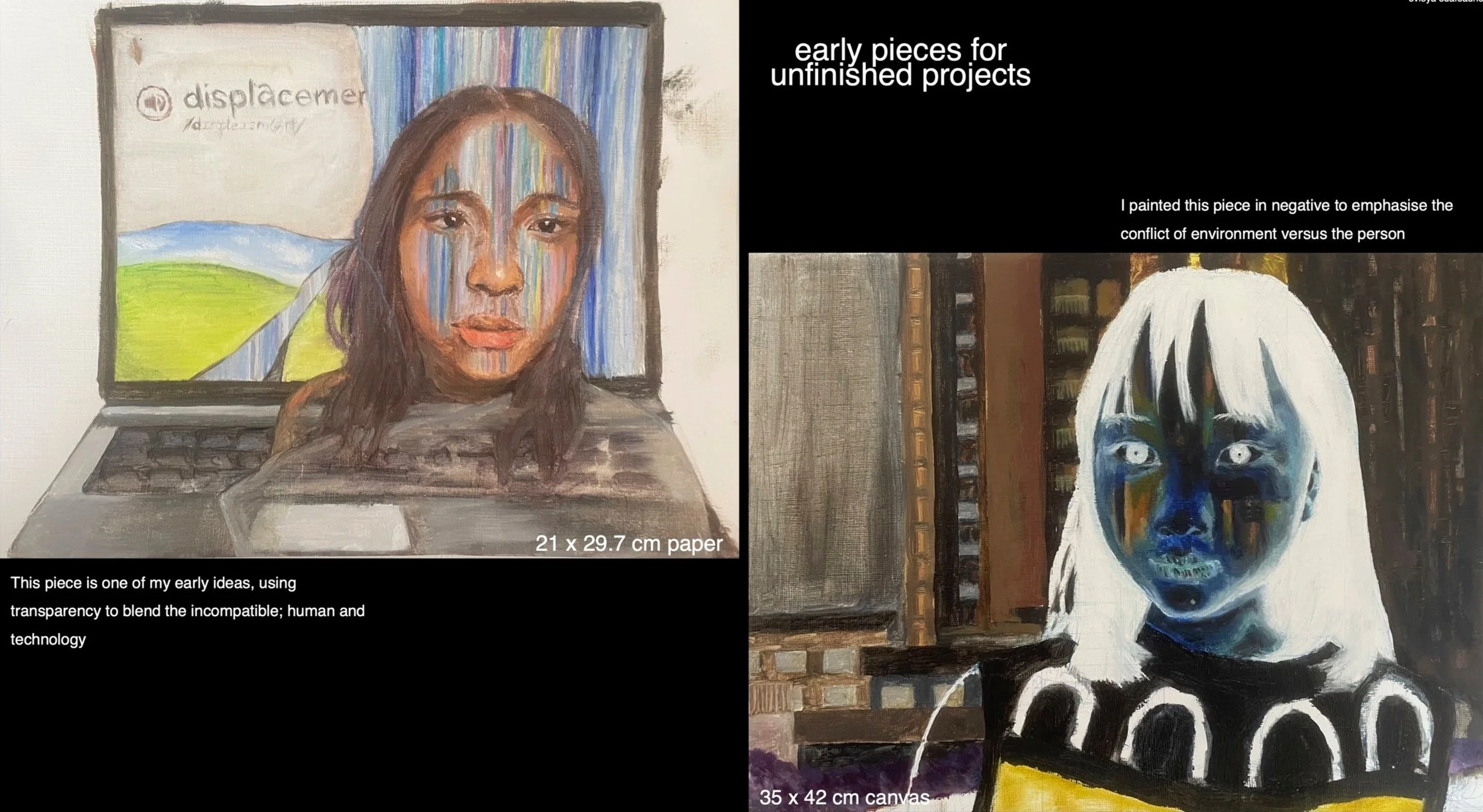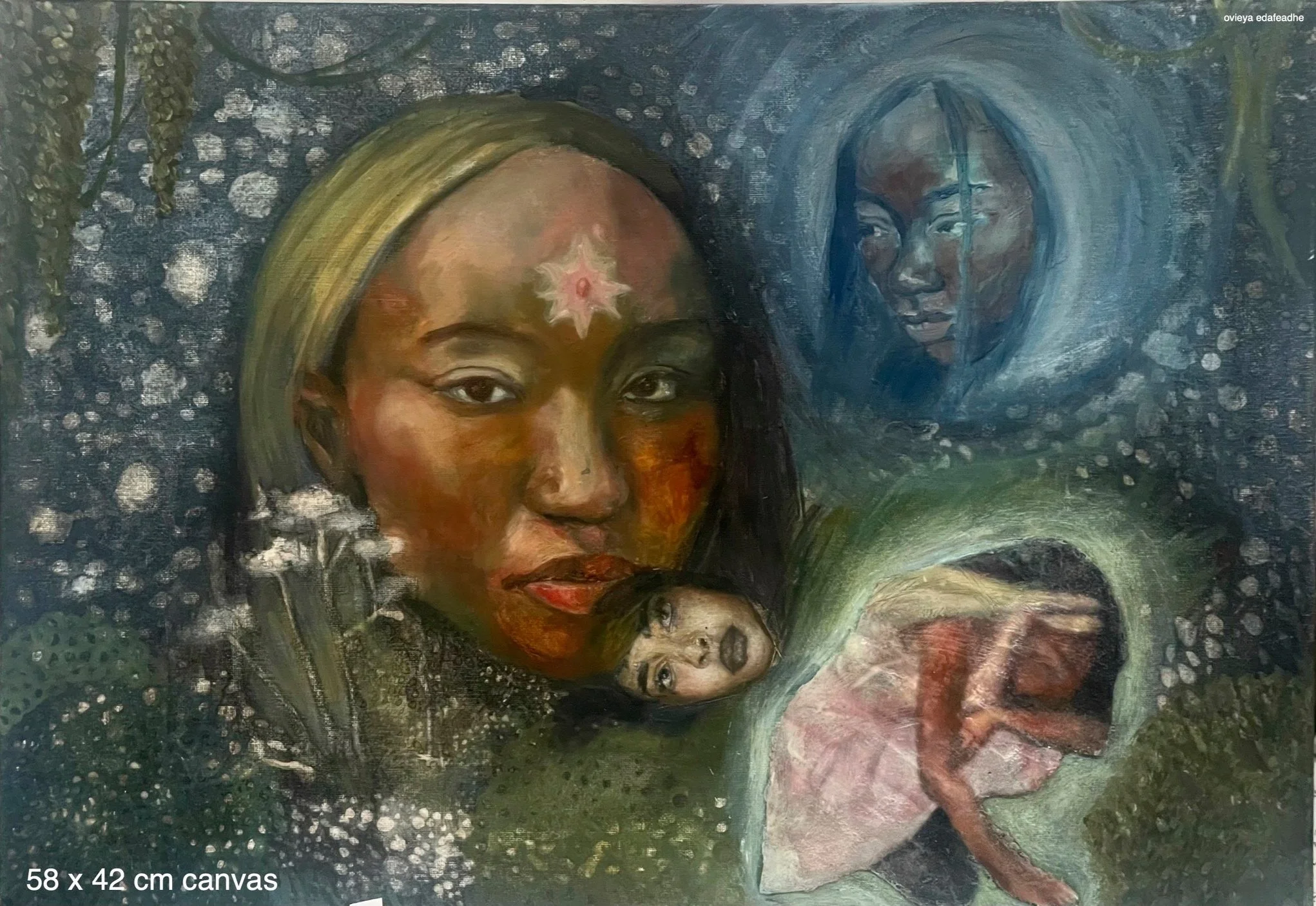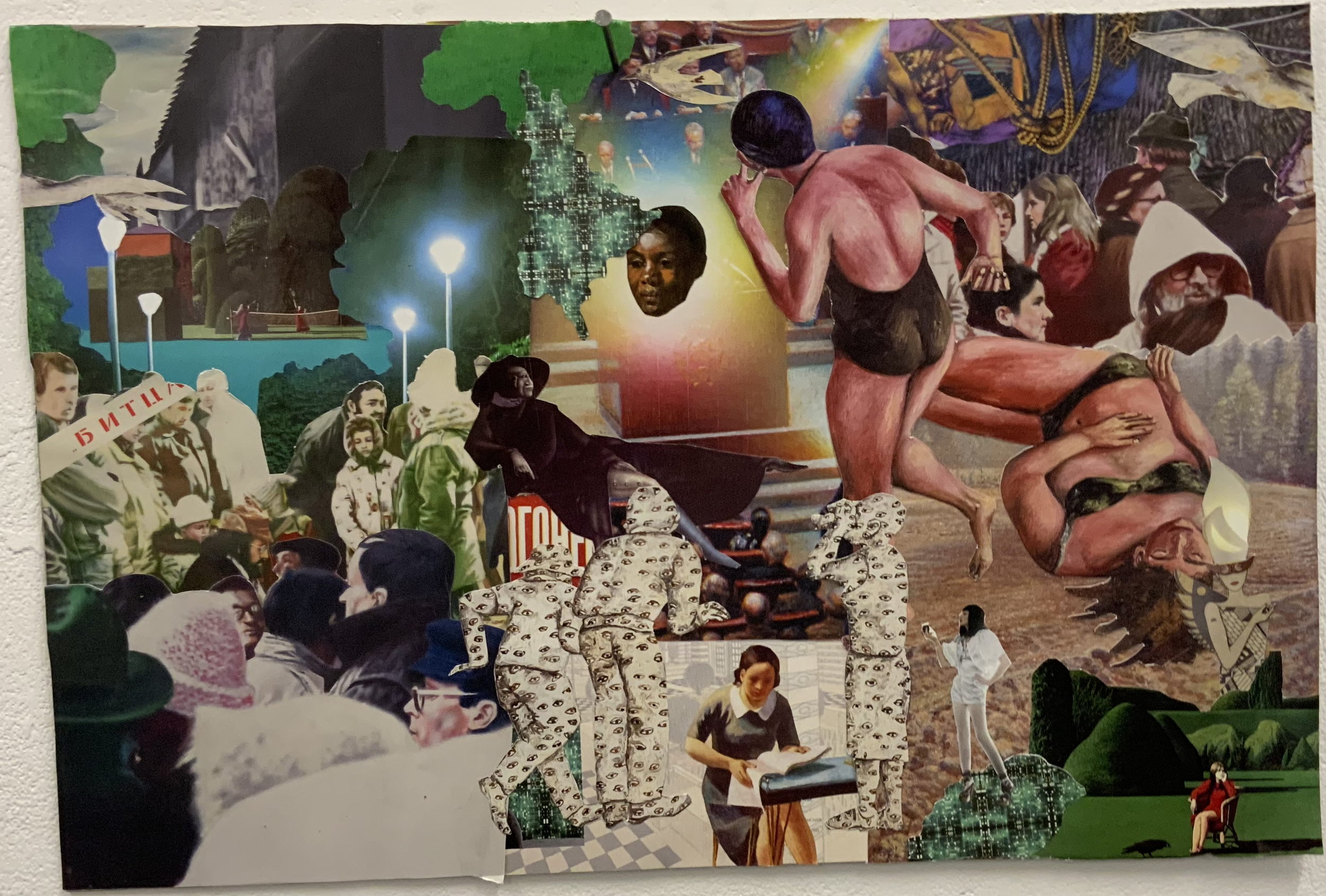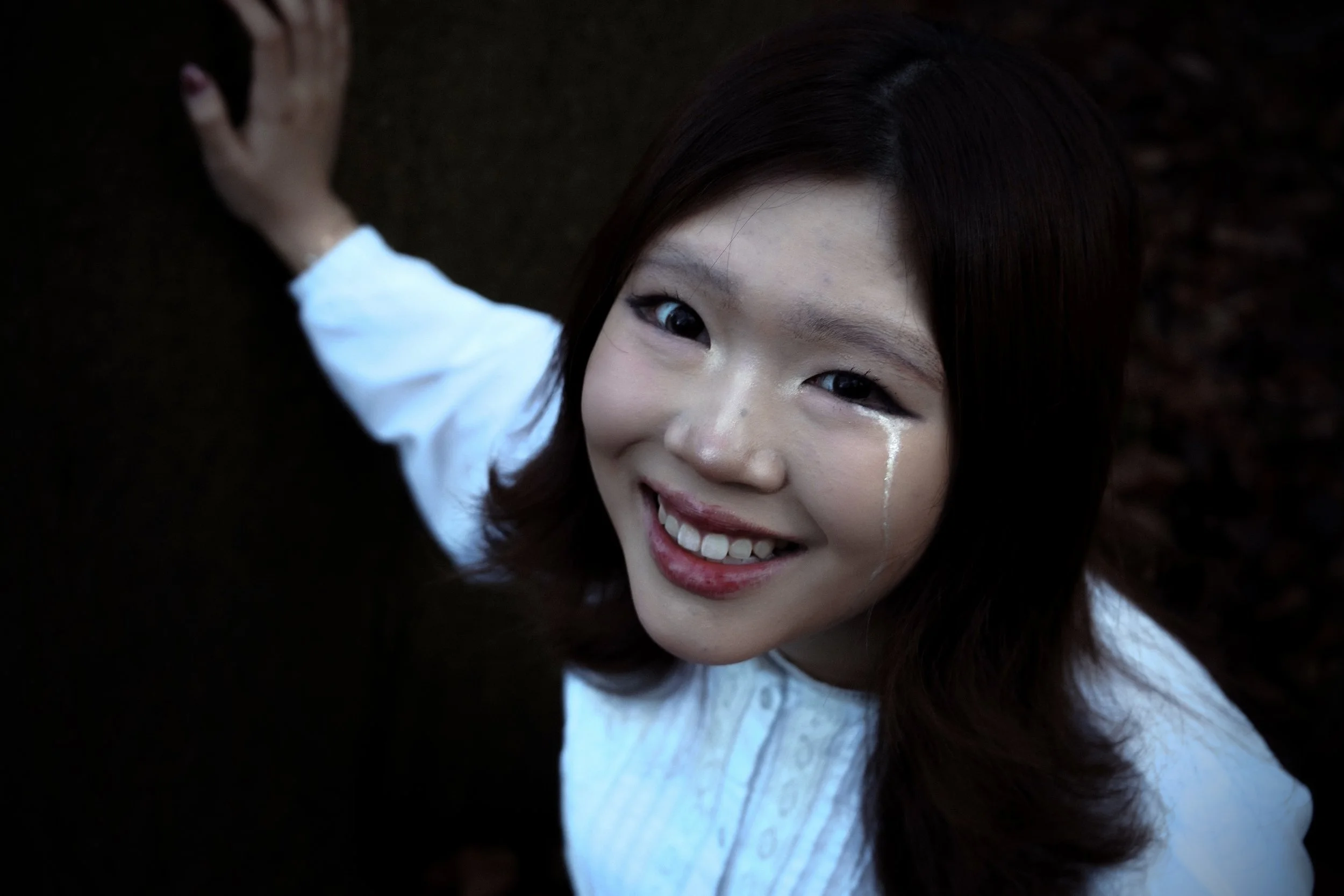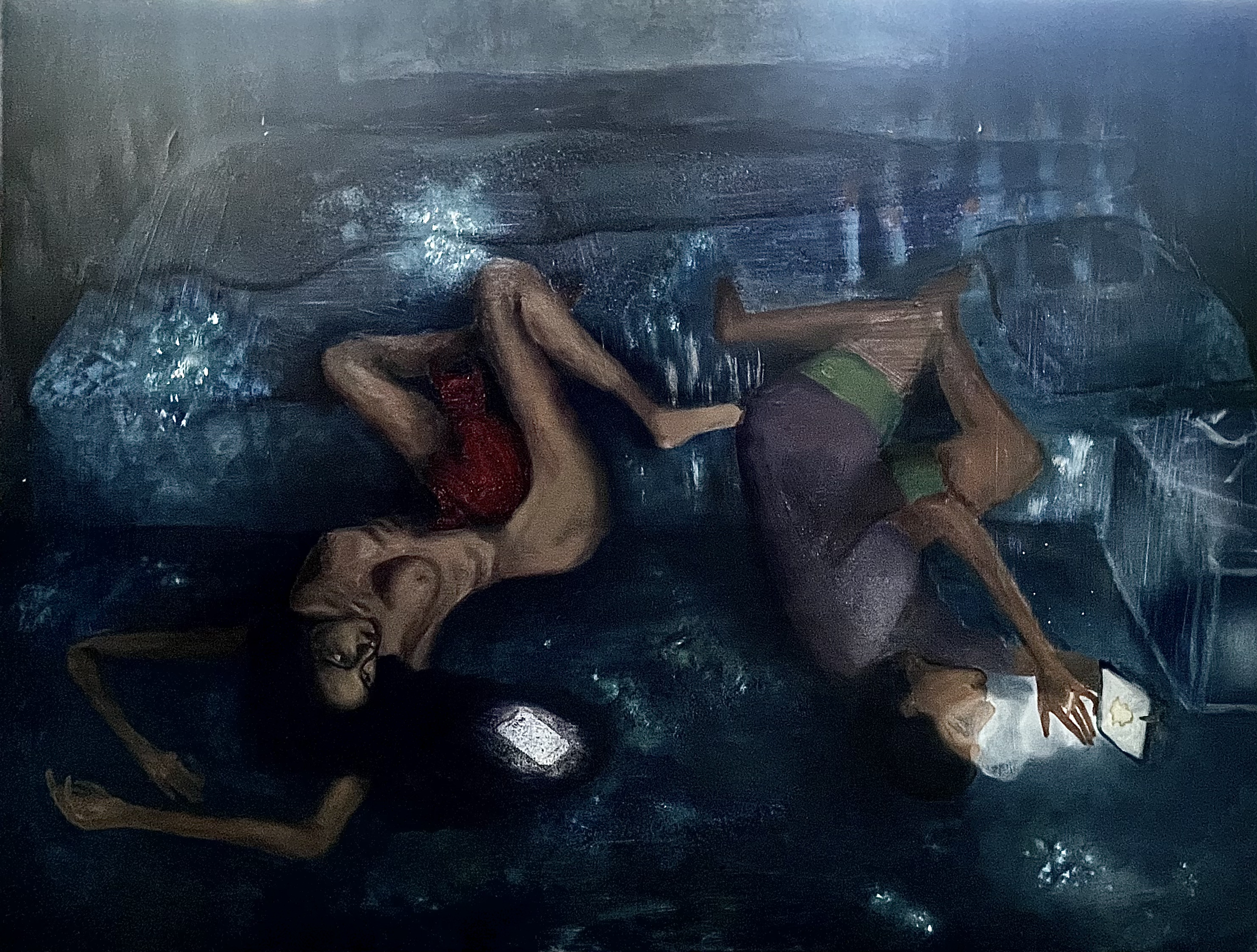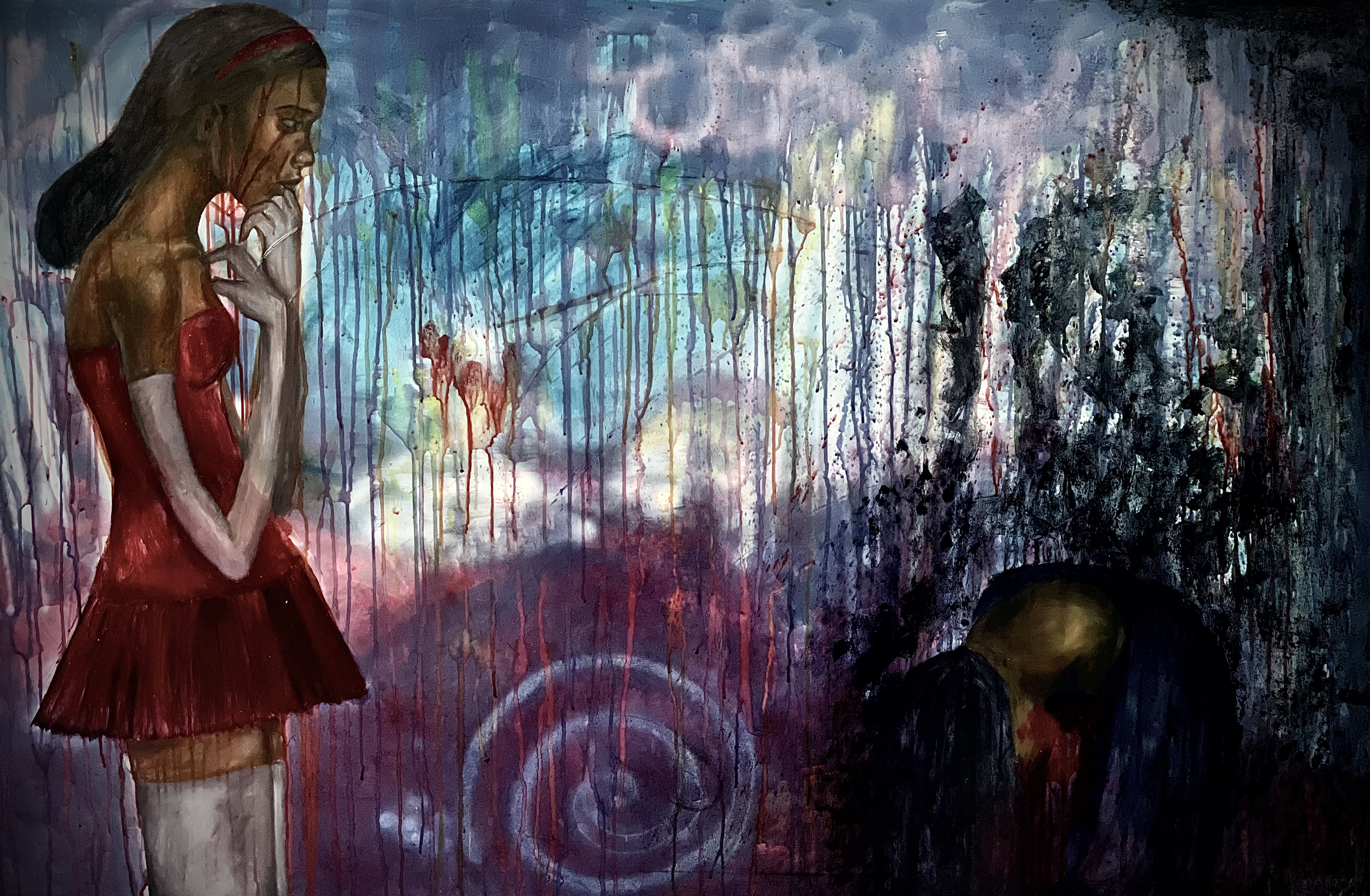portfolio
This oil painting comprises three self-portraits, each representing a distinct facet of adolescence: the anguish of losing connection with childhood, the weary weight of the present, and the anxiety of an uncertain future. The composition is threaded with luminous, glowy sections that introduce a sense of mystery and an eerie atmosphere. The glowing stars were created separately using acrylic paint on baking paper and later affixed to the canvas, adding a textured, ethereal dimension to the work.
This piece explores the simultaneous grandeur and confusion of adolescence and the transition into the wider world. A blue figure emerges in the background, surrounded by short, multicoloured paint strokes that radiate outward, suggesting movement and emotional intensity. Gold ink is used prominently, evoking a sense of transformation and inner luminosity. This work also marks an early stage in the project’s ongoing experimentation with techniques to achieve a glowing, ethereal effect through paint.
I made this with oil pastels and a fork to scratch off parts for the poem I wrote and the moon. Here I used the unearthly glow again and transparency to convey my theme of adolescence.
I wanted to try making a clay and cloth doll/set of dolls, since playing with dolls was a formative part of my childhood. As I researched, it allowed me to reflect on interests and trace the path of my growth, and revisit the various phases and stages that have shaped me into the person I am.
In this piece, the delicate balance between harmonious colours and their complementary opposites are depicted as the artist works intuitively with ink, bleach, and oil paint to create a richly layered composition. Once again, she seeks to evoke a sense of intangibility, fog, and a preternatural translucency, a spectral atmosphere surrounding a figure not fully anchored in reality. The subject hovers between presence and absence, emerging softly from the canvas like a persona half-remembered, embodying a liminal state where form, light, and emotion drift together in quiet, wraithlike tension.
In this painting, I wanted to depict a gradient from traditional to digital art with two connected portraits of me and a nude background. Everything is oil paint save for the face on the right and the background, which are digitally added in. Using oil paint, a very traditional medium juxtaposes with the newly realised medium of digital art. It also inspired me to lessen my focus on strict hyper-realism and delve into more expressionist techniques.
The piece on the left is easiest seen through the ‘negative’ filter of the iPhone, hence the title ‘Made in California’. Ergo, this piece is, again, entrenched in identity and nationality where the figure, born in an environment of superfluous technology, ‘melting-pot’ environments and international boarding schools, oft tackles with her nuanced identity.
Briney mark-making is used here as a means to construct a phantasmal, ethereal figure suspended in an airy, oceanic expanse. Through deliberate strokes and textured layers, a spectral form emerges delicate and translucent, drawing viewers into a liminal space where the tangible dissolves into the intangible. Her eyes became a focal point, imbued with a sense of longing and quiet regret, gently guiding the emotional current of the work.
Here stands a mermaid, adorned with genuine Caribbean seashells and resting upon real sand gathered from the shores of St. Barts. She inhabits a vast, dreamlike desert, a sun-bleached expanse where, on the distant right-hand side of the composition, a shimmering mirage of water emerges, elusive and illusory.
still life
This piece is a quiet meditation on the solitude that arises from emotional disorientation and a fractured sense of self. The figure sits alone, her posture heavy with melancholia, inviting the viewer to contemplate the silent question echoed in her gaze: “Why was I raised this way?” Rooted in personal narrative, the work reflects on the emotional complexities of growing up within a traditional Nigerian household, capturing the tension between inherited cultural values and the realities of a multicultural Western environment. Rendered in layered tones of yellow-brown against a complementary purple-blue background, the composition visually articulates a sense of internal conflict and disconnection. Through this lens, the piece extends its relevance to broader experiences of diasporic identity, asking how cultural legacies shape our emotional fluency and interpersonal dynamics. Ultimately, it offers a poised reflection on the quiet ache of identity, heritage, and the unspoken labour of self-understanding.
This piece unfolds a fantastical, dreamlike composition that foregrounds the figure’s sense of alienation and displacement from reality. Cast into the realm of imagination, the luminous figure in the bottom right is crafted from wax-dipped linen and delicately painted in oil, highlighting the material tension between the hydrophobic wax and the surrounding blue water, where her peers glide effortlessly.
This piece explores emotional intensity and fragmentation through a surreal, symbolic tableau. The central figure, sickly, searching, almost spectral, embodies the raw yearning and dysregulation that characterise the experience with borderline personality disorder. Surrounding her, a dreamlike constellation of giraffes, birds, musical notes, and a sleeping infant evoke both chaos and tenderness, mirroring the unpredictability of emotional connection. The ghostly figure waiting at a bus stop contrasts the central cyclist in motion, symbolising the push-pull of isolation and desire. A “STOP” sign underfoot becomes a subtle metaphor for emotional stalling and blocked intimacy. Cosmic elements overlaying a banal urban setting transform the scene into a psychological map, layered, nonlinear, shaped by memory and longing. Ethereal forms thread through the composition, while the lapwings in flight and forlorn gaze of the protagonist nod to literary tragedy and obsessive love. Whimsical yet mournful, the baby atop the giraffe hints at future desires shadowed by melancholy. Ultimately, this work is a meditation on the sublime emotional landscape—where beauty, longing, and futility intertwine in a space both deeply personal and universally felt.
This collage is composed of ephemera from a once-shared life, postcards, a couple’s therapy task, a barcode from a shared song, fragments of lyrics recontextualised on paper, and excerpts from novels and magazines. These fragments serve not only as vessels of memory, but as didactic markers guiding a quiet acceptance of the past, both as it was and as it remains. A soundscape accompanies the work: a song frequently played during the time these pieces were collected. Its ambient tone acts as a sensory trace, forming a metaphorical diary of love's impermanence. The piece as a whole reflects on love as something fleeting, fragile, subjective, and irrevocably past.
This work experiments with chiaroscuro to heighten emotional drama and visual immediacy. The central figure, biting down on a secondary subject, is illuminated with stark, theatrical lighting that echoes the intensity of operatic stills. This method allowed for swift execution, ideal for my larger vision of composing a series of cinematic, fairytale-inflected tableaux. The deep shadows and ghostly glow evoke a sense of catharsis and tension, drawing from Aristotle’s concept of sophrosyne. Rooted in the haunting aesthetics of folklore, the contrast-rich palette creates a timeless, spectral atmosphere, aligning with my broader aim to distill fairytale themes through a contemporary, psychological lens.
Eponymously titles after the Cocteau Twins song, ‘Why Do You Love Me’ depicts a fevered lover’s embrace. The central figure clutches her partner with such intensity that her fang-like breasts pierce through the other’s flesh, causing heart shaped blood to river down a designer shirt. Still, her lightly closed eyes and fluttering smile don’t show acknowledged violence, but surrender and contentment as she’s surrounded by a childlike surreality. The muted purples and glowing whites contrast against the sharp red while simultaneously creating a dreamlike atmosphere. Around them bloom symbolic elements: Olympic laurels unbound and stripped of the traditional gold and painted in its contemporary purple, roses inspired by that of ‘Beauty and the Beast’, the controversial yet widely loved story passed down and reinterpreted across cultures, heavy hearted pear branches reminiscent of those that’d drop in spring in my childhood garden, and ferns, that connote resilience and hope for the future, peeking timidly from behind the faceless lover. A whimsical tree twisted and lyrical, in the style of Kay Nielsen, and the Ivan Bilibin reminiscent folk art borders frame the figures in a realistic portrayal of an illustration from a children’s romantic fable. The textured border is the boundary, further isolating the couple from a pallid outer world to the gaping but fragile inner world of desire and hollow romances. The main figures face is the most realistic, anchoring the viewer to watch her enjoy her blissful fantasy. Meanwhile, her gaudy lover’s shocked stillness indicated her covert, unspoken strain at the need to hold the heavy, piercing love presented to her in this victorious hug. Interpretation and subjectivity are at the heart of this series, and in this piece it manifests on all layers, inviting themes of romantic acceptance, fragility, and passion. The overall effect is one of intimate storytelling, leaving the viewer to contemplate the unspoken emotions and narratives embedded within the embrace.
Like the gibbous moon and its black crescent, in this intimate scene the main figure reaches outward, seeking affirmation and identity in the eyes of her lover. She both reaches out around her other and clutches her feet against the bed so as to try to anchor herself. This frames her intimacy as a paradox, or at least as inauthentic as she both opens her heart and reserves it. The weeping background is more pale and fragile than the others, showing the hesitancy and frangibility of these early stages in their relationship, and her sexuality must be delicate and unassuming, lest she be seen as promiscuous. Still, in this bed, the world around is dissolved and unrealistic, allowing feeling to be at the vanguard. The embrace vaguely mirrors Klimt’s kiss, a highly subjective piece, where it’s debatable whether a purely romantic scene is taking place or whether it’s a display of romanticised misogyny. Similarly, subjectivity is at the centre of this piece where we question what is wrong between these two figures. And so the composition is tender but uneasy, they hug each other yet desperation is contrasted with nonchalance, or pleasure is contrasted with contempt, or pain is contrasted with stoic acceptance, etc. The figure’s position therefore highlights the BPD experience of yearning for passionate fusion with another. Her hair snakes and coils outward, all of her is alive and moving and restless, her self is expanding to grasp onto her lover like phototropism. The benzene ring on her lower body represents the ouroboros, signifying cycles of endless recreation and destruction, rebirth then suicide. It’s attached to the figure in reference to the ‘cutie mark’ from another children’s tv show called ‘My Little Pony’, a symbol that appears on one’s flank at puberty for purpose of defining a character’s role in life.
This painting shows more hesitancy and tension in this intimate scene, where the two figures lie distant and emotionally estranged. The main character is aching and waiting, somewhat bored and simultaneously on the same ground as her lover. Through its stormy brushstrokes and airy composition, the piece shows the negative space between people, particularly under the heavy colouring of mental illnesses. A galaxy twists and churns between them and the girl on the left, gaunt and sickly, hangs in a posed and stiff, with one foot gently bridging the gap to hesitantly try to gain her lover’s attention. On her stomach rests the only red colour on the canvas, an Alp) from German folklore, which attacks in the night and rides on a sleeping person, giving it sweat inducing, horrific nightmares and when the sleeper awakes, it is paralysed under the Alp’s weight. The red pulses like a wound against the dark blues and pale browns, expressing inner turmoils. Across the composition, the second figure is hunched and relaxed and casually absorbed in the cold, synthetic light of her tablet’s Snapchat app. The navy, glittering night of the bedroom blurs and winks around the shimmering ache of the central figure’s quiet heartbreak.
This painting pulses with the violence of a tragic catastrophe, capturing a moment that flutters circa rage and ruin. The relationship is torn and stretched by power struggle, trauma, and a desperate call for revenge. The central figure kneels with a twisted face, in an expression of anguish and rage. Dressed in a schoolgirl uniform, she is cast with the light of learned helplessness and childlike vulnerability. She wears glittery red shoes reminiscent of the ruby slippers from ‘The Wizard of Oz’ to signal longing for safety and home. The background’s muted, mudded tones thin like violin strings around the scene as her hands, both accusatory and desperate, encircle her partner’s throat. The dying lover dons a Balenciaga shirt, surface-level emblem of status that stands hollow in the face of real romantic rot. Raised in her hand is a Thunderbird totem, a figure in Native American mythos stacked with meanings of strength, dominance, and hegemony. By flapping its wings it can cause thunder and with its eyes or talons it can hurl lightning bolts from the sky. Whether its wielded in defence of her lover or in denial of her true vulnerability, its presences indicated an uneasy inheritance of power and the overcoming of such an ill through this murder. The push for control and pull for attention is finally ended and the main figure can hopefully soon breathe and think clearly without the constant internal struggle. It invites a catharsis for the viewer where love has curdled through warfare, and human needs repressed.
This painting, by far the largest of the series, is a harrowing scene of revelation and collapse where our main girl looks out just over the body of the lover she murdered. Her halloween costume is that of the character Rumi from Satoshi Kon’s ‘Perfect Blue’ who commits a series of murders in the name of deluded revenge and wanting to be the perfect seeming pop-star she’s friends with. Through this unconscious invocation, the figure is no longer just layered with conflicts of identity, cultural standards for perfection, mental illness, need for connection, etc. but now the sobering reality of what she has done. The composition explodes with contrasts of loud, dark, and oscillating colours, the glitter spiking past the matte canvas, creating a visual pandemonium to mirror the protagonist’s mess. Her pose is tense and mesmerised, her costume turns whimsical fantasy to sardonic tragedy. The red is more expansive here compared to the previous pieces; it’s bloody and blazing with insistence so you’re unable to deny its uncomfortable presence. In the far right, the dead lover slumps, almost swallowed by the dark of her shadow while the main figure gazes just beyond in a moment suspended in horror as anagnorisis strikes. The realisation that the emotional torment she endured does not correlate directly proportional to the magnitude of her act creates a painful dissonance, leading to the possibility for catharsis, and, in its aftermath, sophrosyne.

